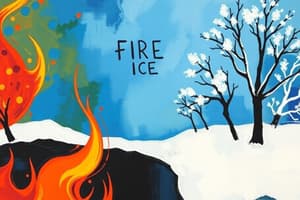Podcast
Questions and Answers
What does fire symbolize in the context of the text?
What does fire symbolize in the context of the text?
- Calmness
- Stillness
- Passion (correct)
- Tranquility
In Norse mythology, what do figures representing light, heat, and life stand opposed to?
In Norse mythology, what do figures representing light, heat, and life stand opposed to?
- Darkness, warmth, and life
- Darkness, energy, and death
- Darkness, cold, and death (correct)
- Cold, cooling, and life
Which literary work by Jules Verne introduced the concept of an icy underworld with eternal flames?
Which literary work by Jules Verne introduced the concept of an icy underworld with eternal flames?
- _Le Château des Carpates_ (correct)
- _Journey to the Center of the Earth_
- _Around the World in 80 Days_
- _Twenty Thousand Leagues Under the Sea_
What does ice represent symbolically in the text?
What does ice represent symbolically in the text?
Which author's work features a deadly battle between fire and ice in a poem titled 'The Cremator'?
Which author's work features a deadly battle between fire and ice in a poem titled 'The Cremator'?
In George RR Martin's 'A Song of Ice and Fire' series, where are battle lines drawn between fire and ice?
In George RR Martin's 'A Song of Ice and Fire' series, where are battle lines drawn between fire and ice?
What do fire and ice symbolize when used together in literary works?
What do fire and ice symbolize when used together in literary works?
In Don Quixote, what does Sancho Panza's devotion to warmth symbolize?
In Don Quixote, what does Sancho Panza's devotion to warmth symbolize?
How does Great Expectations by Charles Dickens use fire and ice symbolically?
How does Great Expectations by Charles Dickens use fire and ice symbolically?
In climate fiction (cli-fi), what themes are explored through the relationship between fire and ice?
In climate fiction (cli-fi), what themes are explored through the relationship between fire and ice?
What real-life systems demonstrate the intricate dance between heat and cold on Earth?
What real-life systems demonstrate the intricate dance between heat and cold on Earth?
How do geologists studying melting ice contribute to environmental understanding?
How do geologists studying melting ice contribute to environmental understanding?
Flashcards are hidden until you start studying
Study Notes
Fire and Ice: A Tale of Contrasts
Throughout human history, fire and ice have captivated our imagination, often appearing together in stories, myths, art, and even science to represent contrasting yet interconnected forces of nature. In this piece, we'll delve into these two elements as they unfold within various incarnations of literature, symbolism, and scientific phenomena.
Origin Story and Symbolism
The pairing of fire and ice first gained popularity with the release of Jules Verne's novella Le Château des Carpates ("Castle of Carpathia") in 1892, later retitled Ice World. Verne envisioned an icy underworld beneath Earth's surface, where eternal flames ignited cavernous chambers. This meld was further popularized by Robert W. Service's iconic poem "The Cremator," published in 1916, which centers around a deadly battle between an inferno and a glacier.
In Norse mythology, similar imagery is found in Ragnarök—the apocalyptic event foretelling the ultimate confrontation between figures representing light, heat, and life (Odin), opposed by darkness, cold, and death (Loki). More contemporary examples include George RR Martin's "A Song of Ice and Fire" series and HBO's adaptation Game of Thrones, wherein battle lines are drawn between the fiery North and the icy Starks' ancestral home.
Symbolically, fire represents passion, creation, energy, and purification, while ice denotes calmness, tranquility, stillness, and preservation. Together, fire and ice signify transformation, rebirth from destruction, and harmony amidst chaos.
Literary Themes
Across literary works, fire and ice are frequently employed to underscore specific narrative arcs, character development, and thematic choices. For instance, Miguel de Cervantes' acclaimed masterpiece Don Quixote juxtaposes Sancho Panza's devotion to warmth and shelter—a representation of security (fire)—against Don Quixote's quest for adventure, glory, honor, and justice—an embodiment of danger and change (ice).
Similarly, Charles Dickens' classic tale Great Expectations, set against the backdrop of frozen marshes and blisteringly hot summer days, draws parallels between Pip's pursuit of wealth and social status—represented through fluctuating landscapes—and his gradual understanding of true worth and virtue.
Climate fiction (cli-fi) also explores the relationship between fire and ice through storylines about global warming, natural disasters, ecological collapse, and societal shifts caused by extreme weather events. For example, Margaret Atwood's novel MaddAddam describes a dystopian world ravaged by multiple climate catastrophes, highlighting the consequences of a polarized society unable to find common ground regarding environmental concerns.
Scientific Connections
While largely referential in their literary applications, it's essential to acknowledge real-life correlatives connecting fire and ice. Geothermal systems, volcanic eruptions, hydrothermal vents, and ice caps all demonstrate the intricate dance between heat and cold across planet Earth's diverse ecosystems. Moreover, terrestrial glaciologists study how melting ice influences local topography and impacts water availability, contributing to landform evolution, sediment transport, and subsequent wildfires.
Ancient oceanographic processes brought forth the present-day geographical distribution of continents, oceans, and climates, greatly influencing human settlement patterns throughout history. Consequently, today's environmental debates concerning sustainability, conservation efforts, carbon emissions, and sea level rise revolve primarily around the delicate balance between fire (energy consumption) and ice (climatic stability).
As you consider the entwined narratives of fire and ice, remember their larger implications extending beyond literature's dreamscapes; they reverberate deeply across scientific disciplines, reflecting upon our very existence as inhabitants of this complex dance between opposites.
Studying That Suits You
Use AI to generate personalized quizzes and flashcards to suit your learning preferences.




